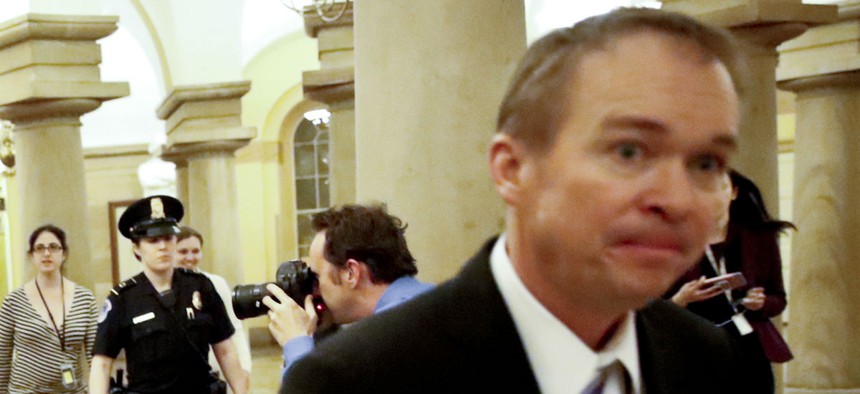
White House Budget Director Mick Mulvaney. AP Photo/Alex Brandon
OMB’s Budget Guidance Draws Mixed Reaction From Employee Groups
Organizations welcome the end of the hiring freeze, but remain skeptical of efforts to reorganize government.
Organizations representing federal employees and managers expressed a mix of optimism and skepticism in response to Wednesday’s guidance to agencies from the Office of Management and Budget.
The memo ends the temporary hiring freeze that President Trump imposed in January, but instructs agencies to come up with plans by June 30 to reduce their personnel footprint. OMB Director Mick Mulvaney also confirmed that President Trump would propose an across-the-board 1.9 percent pay increase for federal workers in his fiscal 2018 budget request, although he didn’t specify what portion would be included in base pay and what would go toward locality adjustments.
By and large, good governance groups and organizations representing federal employees praised the end of the hiring freeze and impending pay raise. But many were suspicious of efforts to reorganize agencies and reduce the size of the federal workforce.
“There is a lot in this memo that will require agencies to read through it carefully, but there is a lot to be optimistic about,” said Terry Gerton, president and CEO of the National Academy of Public Administration. “It tackles the workforce planning issues that really need to be addressed. It supports evidence-based decision-making. It provides the guidelines agencies needed to be able to get more specific about their restructuring recommendations.”
J. David Cox, national president of the American Federation of Government Employees, said a holistic examination of the federal management structure could be a strong step toward a more efficient and effective workforce.
“One good idea [in the memo] takes a page from President Clinton’s ‘reinventing government’ initiative and asks agencies to take a hard look at the organizational chart to see whether there are too many layers of management,” Cox said. “As representatives of front-line employees, AFGE members can tell you that excessive ratios of managers to workers on the front lines creates operational inefficiency and takes resources away from the direct provision of services to taxpayers.”
But employee group leaders warned that Mulvaney’s memo to agencies contains a number of pitfalls. Tony Reardon, president of the National Treasury Employees Union, said ordering staff reduction plans is premature and could overstep the authority of the administrative branch.
“Requiring government agencies to draft detailed plans for downsizing based on a budget that has yet to be released, let alone gone through the congressional appropriations process, is a wasteful exercise,” Reardon said. “Taxpayers deserve federal agencies that can fully deliver services that they rely on every day. This is not how we effectively provide food safety, innovative medical breakthroughs, strong borders and the thousands of other services federal employees undertake each day.”
And while Senior Executives Association President Bill Valdez applauded plans to find and eliminate duplicative or outdated programs within the government, he said the exercise will be misguided if done solely by political appointees.
“The biggest pitfall is if they do not include the career [senior executive service] and career leaders in this activity,” Valdez said. “There’s two issues that concern us. One is that they’re new to government, and this is really complex and requires a deep understanding of the way government works and where programs should be modified, reorganized, etc. Secondly, there are a lot of agencies that do not have political leadership in place yet, or at most a thin political leadership in place.”
Officials also feared negative impacts associated with the logistics of reducing the federal government’s footprint. Cox said that often, federal workforce cuts lead to increased use of private contractors, which he argued doesn’t actually save taxpayers money. And using attrition to cut government jobs often reduces government’s effectiveness.
“Reducing the federal workforce through attrition may seem like a relatively humane approach, but its operational effect can be devastating,” he said. “Federal agencies must be permitted to make decisions about sourcing and hiring that promote the most efficient means of carrying out their mission as dictated by law and policy.”
Valdez said that while some ideas that originate in the private sector could be employed to reform government operations, “running government like a business” could be disastrous in areas like acquisition.
“For example, one of the things I think is desperately needed in the federal government is what Google and other high tech companies do in terms of ‘teaming’ and breaking down institutional silos,” Valdez said. “But one area that [private sector principles] shouldn’t be used is in the acquisition processes. The way that the government procures goods and services is fundamentally unique, and trying to overlay private sector business practices onto public sector business practices would be catastrophic.”
Correction: The original story misattributed a quote by J. David Cox to another official, and incorrectly quoted Cox in another instance. The story has been corrected.







